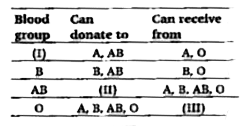Read the statements given below and identify the suitable option :
(i) Eye of Octopus and mammals are homologous.
(ii) sweet potato and photo are analogous.
(iii) Thorus of Bougainville and tendrils of Cucurbita are homologous
(i) is true and (ii ) is false
(ii) is true and (iii) is false
(i) and (ii) both are true
(i) is false and (ii) and (iii) true
The correct Answer is:D
To solve the question, we need to analyze each statement regarding homologous and analogous organs:
Step 1: Analyze the First Statement
Statement (i): Eye of Octopus and mammals are homologous.
- Analysis: The eye of an octopus (a mollusk) and the eye of mammals (vertebrates) do not share a common evolutionary ancestor. They have evolved independently to serve a similar function (vision), which indicates convergent evolution. Therefore, they are analogous, not homologous.
- Conclusion: This statement is false.
Step 2: Analyze the Second Statement
Statement (ii): Sweet potato and potato are analogous.
- Analysis: Sweet potato is a modified root (storage root), while potato is a modified stem (tuber). Despite both being used for food storage, they arise from different structures and origins. This indicates that they are analogous organs.
- Conclusion: This statement is true.
Step 3: Analyze the Third Statement
Statement (iii): Thorns of Bougainvillea and tendrils of Cucurbita are homologous.
- Analysis: Both thorns (from Bougainvillea) and tendrils (from Cucurbita) are modifications of leaves. They have a common origin but serve different functions (protection vs. support). This indicates that they are homologous organs.
- Conclusion: This statement is true.
Final Conclusion
- The first statement is false, while the second and third statements are true. Therefore, the suitable option is D: 1 is false, but 2 and 3 are true statements.
---
Statement (i): Eye of Octopus and mammals are homologous.
- Analysis: The eye of an octopus (a mollusk) and the eye of mammals (vertebrates) do not share a common evolutionary ancestor. They have evolved independently to serve a similar function (vision), which indicates convergent evolution. Therefore, they are analogous, not homologous.
- Conclusion: This statement is false.
Statement (ii): Sweet potato and potato are analogous.
- Analysis: Sweet potato is a modified root (storage root), while potato is a modified stem (tuber). Despite both being used for food storage, they arise from different structures and origins. This indicates that they are analogous organs.
- Conclusion: This statement is true.
Statement (iii): Thorns of Bougainvillea and tendrils of Cucurbita are homologous.
- Analysis: Both thorns (from Bougainvillea) and tendrils (from Cucurbita) are modifications of leaves. They have a common origin but serve different functions (protection vs. support). This indicates that they are homologous organs.
- Conclusion: This statement is true.
- The first statement is false, while the second and third statements are true. Therefore, the suitable option is D: 1 is false, but 2 and 3 are true statements.
Topper's Solved these Questions
Similar Questions
Identify the following paris of Homologous or Analogous organs:
i) Sweet potato and potato
ii) Eye of octopus and eye of mammals
iii) Thorns of Bougainvillea and tendrils of Cucurbits.
iv) Fore limbs of Bat and Whale.
View SolutionIdentify the following paris of Homologous or Analogous organs:
i) Sweet potato and potato
ii) Eye of octopus and eye of mammals
iii) Thorns of Bougainvillea and tendrils of Cucurbits.
iv) Fore limbs of Bat and Whale.
View Solution(a) Select the homologous structures from the combinations given below:
(i) Forelimbs of whales and basts (ii) Tuber of potato and sweet potato (iii) Eyes of octopus and mammals (iv) Thorns of Bougainvillea and tendrils of Cucurbita (b) State the kind of evolution they represent.
View Solution(a) Select the homologous structures from the combinations given below:
(i) Forelimbs of whales and bats (ii) Tuber of potato and sweet potato (iii) Eyes of octopus and mammals (iv) Thorns of Bougainvillea and tendrils of Cucurbita (b) State the kind of evolution they represent.
View SolutionSelect the homologous structures from the combinations given below :
Forelimbs of whales and bats
Tuber of potato and sweet potato
Eyes of octopus and mammals
Thorns of Bougainvillea and tendrils of Cucurbita. (b) State the kind of evolution they represent.
View SolutionIdentify the homologous or analogous pairs of organs among the following by giving proper justification:
Thorn of bougainvillea and tendrils of cucurbita
View SolutionObserve the table given below.

Identify I, II and III
The correct option is
View SolutionObserve the table given below.

Identify I, II and III The correct option is
View SolutionIdentify the examples of homologous structures from the following-
(i) Vertebrate hearts
(ii) Thorns in Bougainvillea and tendrils of Cucurbita.
(iii) Food storage-organs in sweet potato and potato.
View SolutionRead the statements given below and identify the correct option.
(i) A parallelogram has only one line of symmetry.
(ii) A square and a rectangle have the same number of lines of symmetry.
(iii) The diameter of a circle is its line of symmetry.

View Solution